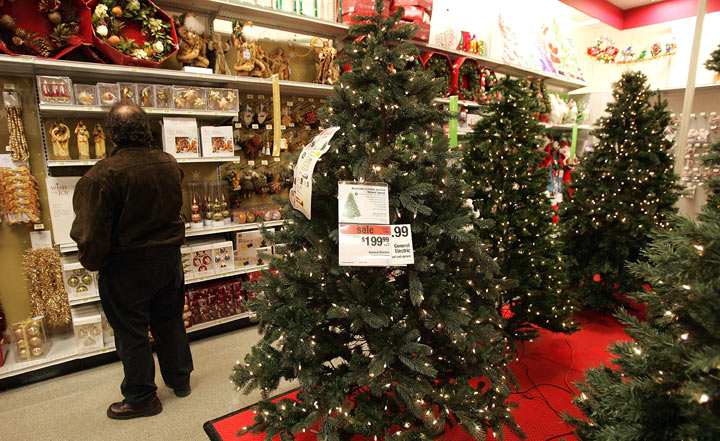TORONTO – Do you know what’s in the holiday products you buy?

While federal regulations are in place for some products that are likely to end up in your kid’s mouth (such as kids jewellery, baby bottles and sippy cups), toxic substances can still end up in your home during the holiday season via toys or holiday decorations.
Inspect children’s jewellery for lead and cadmium
According to Health Canada, although wearing jewellery containing lead doesn’t pose a health risk, swallowing, sucking or chewing this type of jewellery can damage children’s bodies, “especially the nervous system.”
The federal government also warns that cadmium, a popular substitute for lead in costume jewellery, is actually more toxic than lead. Consumers should be wary of children’s jewellery, which could contain either one of these substances, says Maggie MacDonald, the toxics program manager at Environmental Defence, a non-partisan environmental organization.
In July 2011, the Canadian government introduced new guidelines limiting the amount of cadmium that can be used in children’s jewellery. Despite that, in January 2012 Health Canada recalled a range of children’s necklaces, rings, bracelets and anklets because the products contained excessive levels of lead and cadmium.
READ MORE: Health Canada introduces rules on cadmium levels in jewellery for children
MacDonald advises parents to pay attention to the weight of children’s jewellery – if a small piece of jewellery feels relatively heavy, it may contain lead.
Health Canada also recommends that if you suspect your child’s jewellery contains lead or cadmium, throw it out and ask your doctor to test your child’s blood.
Consider a real tree
If you have been using the same fake Christmas tree for a number of years, you may want to consider an upgrade. MacDonald said that many older artificial trees contain lead and PVC plastic.
A 2008 report from the U.S. Environmental Protection Agency found that artificial Christmas trees made of PVC degrade under normal conditions, and when an artificial tree gets to be nine years old, “dangerous lead exposure can occur.”
“Recent studies have found that as plastic trees age, they can start to release a kind of lead dust into your home. That alone could have a real impact on how long we want to keep an artificial tree before replacing it – perhaps with a live tree,” said Jennifer Smith, horticulturist with Kansas State University.
Choose fragrance-free candles and stocking stuffers
Toiletries are often popular items for stocking stuffers, and holiday decorations often include scented candles. However, products containing fragrance often contain phthalates, a family of chemicals which Health Canada says may “adversely affect reproduction and development.”
Click here for the Canadian government’s toxic substances list.
Numerous studies identify health risks associated with phthalate exposure, and Health Canada warns that “it is the amount of phthalates that leach out of the soft vinyl and migrate into the body that can be harmful.” But what that amount is isn’t entirely clear.
To reduce harm to infants and children, the federal government passed new regulations that restrict the allowable amount of phthalates in the soft vinyl of children’s toys and child care products (you can read more about these restrictions below).
But phthalates can still be found in products not meant for kids – especially ones that contain fragrance – which may unintentionally end up in the your child’s mouth.
MacDonald says Environmental Defence operates under a “precautionary principle,” meaning, if there is mounting scientific evidence that a chemical – such as phthalates – poses a health risk, they advocate consumers use the “better safe than sorry” adage and choose products that don’t contain the chemical.
Watch out for soft vinyl children’s toys
In January 2011, Canada introduced new regulations that restrict the amount of phthalates in the soft vinyl of all children’s toys and child care articles in order to limit phthalate exposure to young children.
While Health Canada said that merely touching or licking soft vinyl toy (even those with the restricted amount of phthalates) doesn’t constitute a health risk, parents should monitor the use of kids toys not specifically designed for sucking or chewing (like bibs, bath and squeeze toys) and should remove the product from the child’s environment if they notice their child mouthing the product for an extended period.
Ask for emailed receipts
While you’re out doing holiday shopping, you may be given the option to have receipts emailed to you, rather than receiving a paper copy.
If those receipts are potentially ending up in your bag of holiday snacks, you may want to consider the paperless option: in 2010, the U.S.-based Environmental Working Group found that Bisphenol A (BPA) was found in 40 per cent of receipts tested, a substance typically found in hard plastic bottles and food packaging.
Health Canada says that low levels of BPA do not pose a health risk to the general population, but is more of a risk for newborns and infants, and extra protection has been put into place to protect them from exposure.
In 2008, Canada banned the import and sale of polycarbonate baby bottles containing BPA. In October 2010, Canada formally added BPA to its list of toxic substances.
Experts advise that Canadians wash their hands after handling a receipt or preparing a meal and keep receipts away from children.
Last year, Suffolk County, N.Y., became the first county in the U.S. to ban retailers from issuing receipts that contain BPA.


Comments